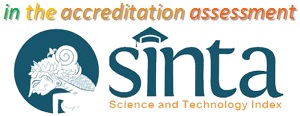Tubercolusis Segmentation Based on X-ray Images
DOI:
https://doi.org/10.37034/medinftech.v1i4.22Keywords:
Segmentation, Normal, Lesion, Color Channel, Edge DetectionAbstract
Tuberculosis or TB is an infectious disease caused by the bacteria Mycobacterium tubercolusis. This disease usually attacks the lungs, but can also affect other organs such as the kidneys, bones and brain. TB is highly contagious, and can spread through the air when someone who is infected coughs or sneezes. Risk factors that can increase a person's chances of developing TB include a weak immune system, such as people with AIDS, diabetes, or people taking immunosuppressant drugs. And people who live or work in environments with high rates of TB transmission are also at risk of infection. Symptoms of TB are usually a cough that lasts more than three weeks, unexplained weight loss, fever, night sweats and persistent fatigue. In more severe cases, TB can cause coughing up blood, chest pain and difficulty breathing. One of the examination tools that can be used to detect TB disease is x-rays. Which produces X-Rays to help and confirm the diagnosis of TB disease, to see the chest part of the body which is used as medical record documentation. In X-ray photos, random dark and light spots of noise are often found which are caused by several factors. Based on the facts above, image segmentation is an important task for doctors in diagnosing disease. Automatic detection or segmentation of lung images from chest x-ray images is the initial stage of the diagnosis process. This research aims to implement a segmentation method to determine edge detection in clearer images using several segmentation methods, namely the Canny Edge Detection method, Sobel reading chest x-ray results for tuberculosis. And canny edge detection with segmented RGB image (otsu's thresholding) produces the highest value, namely 230,466.0 pixels and a lesion volume of 14,818.625 mm3.
Downloads
References
Data World Population Review per pekan kedua februari 20
The top 10 causes of death. World Health Organization Available at, http://www.who.int/news-room/fact-sheets/detail/the-top-10causes-of-death (Accessed: 28th June 2018).
obie, W. C. The Tubercle Bacillus, in the Pulmonary Lesion of Man. Histobacteriology and Its Bearing on the Therapy of Pulmonary Tuberculosis. George Canetti. Q. Rev. Biol. 32, 201–201 (1957).
David S. Barnes. The making of a social disease tuberculosis in nineteenth-century France. (University of California Press, 1995).
Warner, D. F. & Mizrahi, V. Tuberculosis Chemotherapy: the Influence of Bacillary Stress and Damage Response Pathways on Drug Efficacy. Clin. Microbiol. Rev. 19, 558–570 (2006).
Ryan, G. J. et al . Multiple M. tuberculosis Phenotypes in Mouse and Guinea Pig Lung Tissue Revealed by a Dual-Staining Approach. PLOS ONE 5, e11108 (2010).
Wallis, R. S., Palaci, M. & Eisenach, K. Persistence, Not Resistance, Is the Cause of Loss of Isoniazid Effect. J. Infect. Dis. 195, 1870–1871 (2007).
Irwin, S. M. et al . Bedaquiline and Pyrazinamide Treatment Responses Are Affected by Pulmonary Lesion Heterogeneity in Mycobacterium tuberculosis Infected C3HeB/FeJ Mice. ACS Infect. Dis. 2, 251–267 (2016).
A. Saputra, "SISTEM PAKAR IDENTIFIKASI PENYAKIT PARU-PARU PADA," JURNAL TEKNOLOGI DAN INFORMATIKA (TEKNOMATIKA), vol. 1, no. 3, p. 203, SEPTEMBER 2011.
Rulaningtyas, R, and Ain K , Edge Detection For Brain Tumor Pattern









